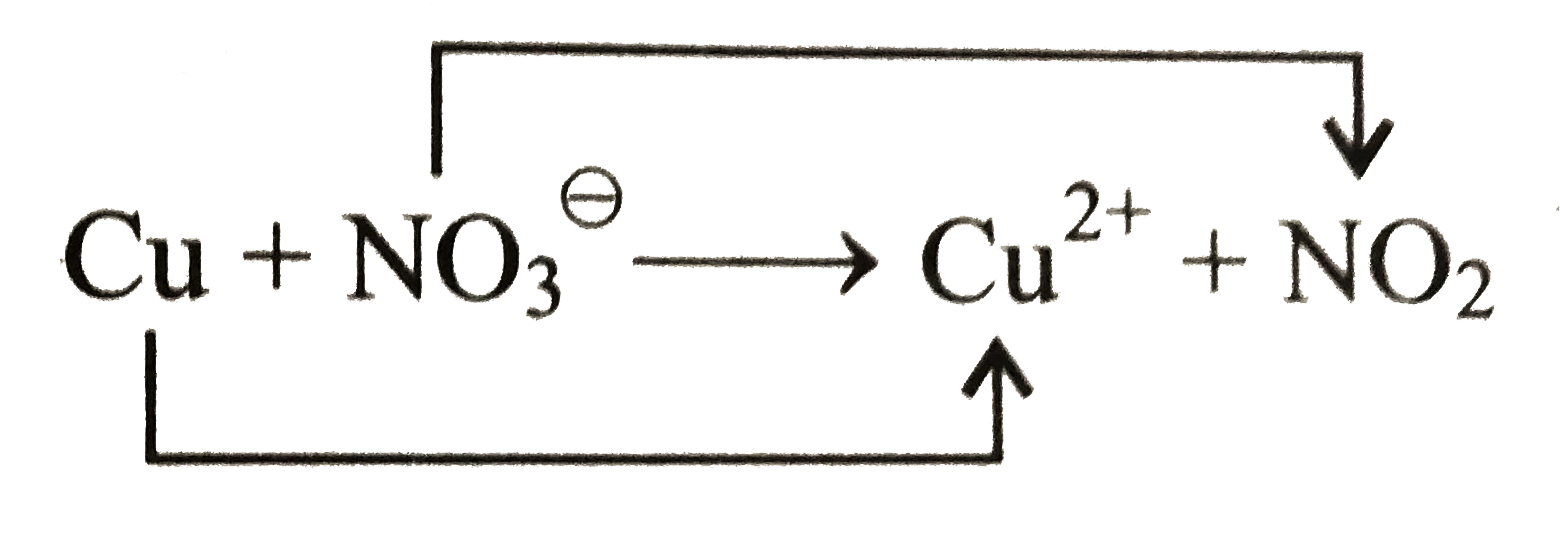Complete Solutions to Solved Examples of chapter REDOX REACTIONS of Class 11 book with complete answers and questions
| Class 11 | CHEMISTRY |
| Chapter | REDOX REACTIONS |
| CENGAGE CHEMISTRY | Solved Examples |
| Number Of Questions | 33 |
| Academic Year | 2023-24 |
Calculate the oxidation number of all the atoms in the following compounds and ions:
a. `PbSO_(4)`, b. `CrO_(4)^(2-)`
View SolutionDetermine the oxidation number of following underline elements:
`HulCN`
View SolutionUsing Stock notation , represent the following compounds , `H AuCl_(4) , Tl_(2)O , FeO , Fe_(2)O_(3) , Cul , CuO , MnO ` and `MnO_(2)` .
View SolutionWhich of the following species do not show disproportionation reaction and why?
`BrO^(ө)` (hypobromirte ion), `BrO_(2)^(ө)` (bromite ion), `BrO_(3)^(ө)`(bromate ion),and `BrO_(4)^(ө)` (perbromate ion)
View SolutionSuggest a scheme of classification of the following redox reactions
(a) `N_(2) (g) + O_(2) (g) to 2 NO (g)`
(b) `2Pb (NO_(3))_(2) (s) to 2 PbO(s) + 4 NO_(2) (g) + O_(2)(g)`
(c) `NaH(s) + H_(2)O(I) to NaOH (aq) + H_(2)(g)`
(d) `2 NO_(2) (g) + 2OH^(-) (aq) to NO_(2)^(-) (aq) + NO_(3)^(-) (aq) + H_(2) O(l)`
View SolutionWhy following two reaction proced differently?
`Pb_(3)O_(4)+8HClrarr3PbCl_(2)+Cl_(2)+4H_(2)O`
and
`Pb_(3)O_(4)+4HNO_(3)rarr2Pb(NO_(3))_(2)+PbO_(2)+2H_(2)O`
View SolutionUse the arbitrary method to balance the following equations:
a. `KIO_(3)+KI+H_(2)SO_(4)rarrKI_(3)+K_(2)SO_(4)+H_(2)O`
b. `Pb(N_(3))_(2)+Co(MnO_(4))_(3)rarrCoO+MnO_(2)+Pb_(3)O_(4)+NO`
c. `K_(4)[Fe(CN)_(6)]+KOH+Ce(NO_(3))_(4)rarr Fe(OH)_(3)+Ce(OH)_(3)+K_(2)CO_(3) +KNO_(3)+H_(2)O`
View SolutionBalance the following equation by oxidation number method.
`KMnO_(4)+H_(2)SO_(4)+H_(2)C_(2)O_(4)toK_(2)SO_(4)+MnSO_(4)+CO_(2)+H_(2)O`
View SolutionBalance the following reaction by oxidation number method:
`CrO_(4)^(2-)+I^(ө)rarrCr^(3+)+IO_(3)^(ө)` ( in alkaline or basic medium)
View SolutionComplete and balance the following in acidic medium:
`Ag^(o+)+AsH_(3)rarrH_(3)AsO_(3)`
View SolutionBalance the following reaction in acidic medium.
`CuS+NO_(3)^(ө)rarrcu^(2+)+S_(8)+NO`
View SolutionBalance the following by ion electron method is basic medium.
`NO_(3)^(ө)+Znrarr Zn^(2+)+NH_(4)^(oplus)`.
View SolutionBalance the following by ion electron method (acidic medium).
`Mn^(2+)+S_(2)O_(8)^(2-)rarrMnO_(4)^(ө)+HSO_(4)^(ө)`
View SolutionBalance the following by ion electron method in acidic medium.
`CIO_(3)^(ө)+I_(2)rarrIO_(3)+CI^(ө)`
View SolutionWhich of the following are examples of disproportionation reactions?
a. `Ag(NH_(3))_(2)^(o+)+2H^(o+)rarrAg^(o+)+2overset(o+)NH_(4)`
b. `Cl_(2)+2overset(ө)OHrarrClO^(ө)+Cl^(ө)+H_(2)O`
c. `CaCO_(3)rarrCaO+CO_(2)`
c. `CaCO_(3)rarrCaO+CO_(2)`
d. `2HgOrarr2Hg+O_(2)`
e. `Cu_(2)O+2H^(o+)rarrCu+Cu^(2+)+H_(2)O`
f. `CuS+O_(2)rarrCu+SO_(2)`
g. `2HCuCl_(2)+"dilute with" H_(2)OrarrCu+Cu^(2+)+4Cl^(ө)+2H^(o+)`
h. `2H_(2)O_(2)rarr2H_(2)O+O_(2)`
View SolutionBalance the following equation in basic medium.
`Cr(OH)_(3)+IO_(3)^(-)toCrO_(4)^(2-)+I^(-)`
View Solution`H_(2)SO_(4)` acts as an oxidising agent, a dehydrating agent, and an acid. Among each of the following reactions, which behaviour is shown by `H_(2)SO_(4)`?
a.`C_(6)H_(12)O_(6)+H_(2)SO_(4)(conc)rarr6C+6H_(2)O`
b. `5H_(2)SO_(4)(conc)+4ZnrarrH_(2)S+4Zn^(2+)+4SO_(4)^(2-)+4H_(2)O`
c. `H_(2)SO_(4)(dil)+ZnrarrZn^(2+)+H_(2)+SO_(4)^(2-)`
d. `H_(2)SO_(4)(dil)ZnCO_(3)rarrZn^(2+)+CO_(2)+CO_(2)+SO_(4)^(2-)+H_(2)O`
View SolutionBalance the equation
`As_(2)S_(3) + NO_(3)^(-) to AsO_(4)^(3-) + NO + S`
in acidic medium
View SolutionFor the reaction
`3Br_(2)+6OH^(ө)-ltBr^(ө)+BrO_(3)^(ө)+3H_(2)O`
Equivalent weight of `Br_(2)` (molecular weitht M) is
View Solution`P_(4)+3overset(ө)OH+3H_(2)Orarr3H_(2)Orarr3H_(2)PO_(2)^(ө)+PH_(3)`
Equivalent weight of `P_(4)` is
View Solution`3KClO_(3)+3H_(2)SO_(4)rarr3KHSO_(4)+HClO_(4)+2ClO_(2)+H_(2)O`
Equivalent weight of `KClO_(3)` is
View Solution`Cu_(2)S+MnO_(4)^(ө)rarrCu^(2+)+Mn^(2+)+SO_(2)`
The equivalent weight of `Cu_(2)S` is
View Solution`As_(2)S_(3)+7NaClO_(3)+12NaOHrarr2Na_(3)AsO_(4)+7NaClO+3Na_(2)SO_(4)+6H_(2)O`
The equivalent weight of `As_(2)S_(3)` is
View SolutionThe equivalent weight of `HNO_(3)` (molecular weight `=63`) in the following reaction is
`3Cu+8HNO_(3)rarr3Cu(NO_(3))_(2)+2NO+4H_(2)O`
View SolutionThe equivalent weight of `H_(2)SO_(4)` in the following reaction is
`Na_(2)Cr_(2)O_(7)+3SO_(2)+H_(2)SO_(4)rarr3Na_(2)SO_(4)+Cr_(2)(SO_(4))_(3)+H_(2)O`
View SolutionThe equivalent weight of potash alum
`(K_(2)SO_(4).Al_(2)(SO_(4))_(3).24H_(2)O)` is
View SolutionCalculate the number of moles of `Cu` and `HNO_(3)` to give `NO` and `NO_(2)` in the `(2:1)` molar ratio.
View SolutionBalance the following equations:
`Mn_(2)O_(7)rarrMnO_(2)+O_(2)`
View SolutionBalance the following equations:
i. `As_(2)S_(3)+NaClO_(3)+NaOHrarrNa_(3)AsO_(4)+NaClO+Na_(2)SO_(4)`
View SolutionWrite a balanced equaiton when copper reacts with nitric acid, a brown gas is fromed and the solution turns blue.

View SolutionQuestion : Balance the following redox equaiton by both methods.
`[Cr(OH)_(4)]^(ө)+H_(2)O_(2)rarrCrO_(4)^(2-)+H_(2)O`(basic medium)
View SolutionBalance the following reactions: `NH_(3)+O_(2) rarr NO + H_(2)O`
View SolutionComplete and balance the following equations: `HI+HNO_(3)rarr?+NO+H_(2)O`
View Solution
Solved Examples questions and complete solutions for chapter REDOX REACTIONS of CENGAGE CHEMISTRY (ENGLISH) of Class 11